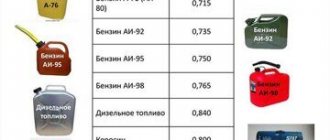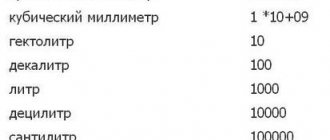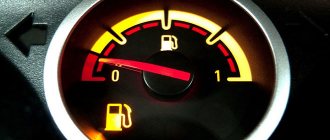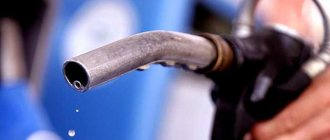How to calculate the density of gasoline?
4. How to measure density
- take any container with graduated divisions;
- weigh the container;
- pour 100 ml of fuel into the container;
- weigh the liquid and find the difference in measurement values;
- divide the result by the volume of fuel.
Aug 9
2022 Interesting materials:
How to store mushroom powder? How to store elderberries? How to store zucchini for first feeding? How to store potatoes in a warm basement? How to store potatoes if it is not possible in the basement? How to store potatoes? How to store bread so it doesn't dry out? How to store jellied meat in the freezer? How to store cranberries on the balcony? How to store coconut paste?
Features of converting gasoline of different brands from liters to tons
To correctly carry out the calculation, you need to know the density values of the required brand of petroleum product based on the table. It is best, of course, to take a fuel sample and measure the density of the fuel at a set temperature according to current standards.
On average, the density of fuel at 20 ºС is 0.75 g/l. Using the directory data and performing a simple calculation, we find that the volume of one ton of gasoline ranges from 1282 to 1429 liters.
To perform more accurate calculations, it is necessary to correct for temperature, because The density according to the standard in the reference books is indicated taking into account the temperature from plus 15 to plus 20 ºС. If the temperature is outside this range, a temperature correction must be taken into account.
Hydrocarbon Density
| Fuel | Density at 20 ºС, g/cm3 |
| Oil | from 0.74 to 0.97 |
| Jet fuel | from 0.76 to 0.84 |
| Automotive fuel | from 0.71 to 0.76 |
| Engine oil | from 0.88 to 0.94 |
| Aviation fuel | from 0.73 to 0.75 |
| Diesel fuel | from 0.80 to 0.85 |
| Fuel oil | from 0.92 to 0.99 |
To accurately calculate the hydrocarbon density using these data at a given temperature, you will need average temperature correction data:
| Density at 20oC | Correction for temperature by 1oC | Density at 20oC | Correction for temperature by 1oC |
| from 0.650 to 0.659 | 0,962 * 10-3 | from 0.830 to 0.839 | 0,725 * 10-3 |
| from 0.660 to 0.669 | 0,949 * 10-3 | from 0.840 to 0.849 | 0,712 * 10-3 |
| from 0.670 to 0.679 | 0,936 * 10-3 | from 0.850 to 0.859 | 0,699 * 10-3 |
| from 0.680 to 0.689 | 0,925 * 10-3 | from 0.860 to 0.869 | 0,686 * 10-3 |
| from 0.690 to 0.699 | 0,910 * 10-3 | from 0.870 to 0.879 | 0,673 * 10-3 |
| from 0.700 to 0.709 | 0,897 * 10-3 | from 0.880 to 0.889 | 0,660 * 10-3 |
| from 0.710 to 0.719 | 0,884 * 10-3 | from 0.890 to 0.899 | 0,647 * 10-3 |
| from 0.720 to 0.729 | 0,870 * 10-3 | from 0.900 to 0.909 | 0,633 * 10-3 |
| from 0.730 to 0.739 | 0,857 * 10-3 | from 0.910 to 0.919 | 0,620 * 10-3 |
| from 0.740 to 0.749 | 0,844 * 10-3 | from 0.920 to 0.929 | 0,607 * 10-3 |
| from 0.750 to 0.759 | 0,831 * 10-3 | from 0.930 to 0.939 | 0,594 * 10-3 |
| from 0.760 to 0.769 | 0,818 * 10-3 | from 0.940 to 0.949 | 0,581 * 10-3 |
| from 0.770 to 0.779 | 0,805 * 10-3 | from 0.950 to 0.959 | 0,567 * 10-3 |
| from 0.780 to 0.789 | 0,792 * 10-3 | from 0.960 to 0.969 | 0,554 * 10-3 |
| from 0.790 to 0.799 | 0,778 * 10-3 | from 0.970 to 0.979 | 0,541 * 10-3 |
| from 0.800 to 0.809 | 0,765 * 10-3 | from 0.980 to 0.989 | 0,528 * 10-3 |
| from 0.810 to 0.819 | 0,752 * 10-3 | from 0.990 to 1.000 | 0,515 * 10-3 |
| from 0.820 to 0.829 | 0,738 * 10-3 |
How to count:
- From the gasoline passport we take the density of the fuel at a temperature of plus 20 oC.
- Determine the average temperature of the fuel in the gas tank.
- We calculate the difference between plus 20 oC and the average fuel temperature.
- Using the temperature correction column, we find a correction of 1oC, which corresponds to the density of the selected fuel at plus 20oC.
- We multiply the temperature correction by the temperature difference.
- We subtract the number obtained in point 5 from the density value at plus 20 oC, if the average temperature of the fuel in the gas tank is higher than plus 20 oC. Or we add this number if the fuel temperature is below plus 20 oC.
For example, the density of gasoline at plus 20 oC from the gasoline passport is 0.801 g/cm3. The temperature of the fuel in the gas tank is plus 25 oC. From the table we take the density of the fuel at a given temperature. We get:
- Temperature difference: 25 oC – 20 oC = 5 oC.
- The temperature correction per 1 oC from the table for a density of 0.801 g/cm3 is equal to 0.765 * 10-3 g/cm3.
- We calculate the correction for temperature by 5 oC: 0.765 * 10-3 * 5 = 0.003825 g/cm3, or approximately 0.0038 g/cm3.
- We determine the required fuel density at a temperature of plus 25 oC (we subtract the correction, since the temperature of the fuel in the gas tank is higher than plus 20 oC): 0.801 - 0.0038 = 0.7972 g/cm3.
The question of how to correctly convert liters of gasoline into tons turned out to be not too difficult.
Conversion formulas
The volume and mass of a liquid are related by the formula: M = V ρ,
where M is the mass of the liquid in tons, V is its volume in m³, ρ is the density in t/m³.
In real practice, managers prefer to deal with tons (fuel purchases) and liters (sales). If the above formula is expressed in terms of these quantities, it will look like this:
M = V ρ /1000
- where ρ is the density of the liquid in kg/l (numerical value),
- V – volume of liquid in liters;
- M – mass of liquid in tons.
To find out, for example, how much 1000 liters of diesel fuel with a density of 0.83 kg/l weigh, we substitute the values in the formula to obtain the mass in tons:
M = 1000 · 0.83 / 1000 = 0.83 t.
The reverse conversion (from tons to liters) is carried out using the formula V = M · 1000/ρ (weight in tons, density in kg/l, volume in liters).
Fuel (diesel, gasoline, and kerosene) physically do not have a constant density - it depends on the temperature of the liquid, decreases with increasing temperature, and increases with its fall.
That is why the conversion of the available mass of fuel into volume for each value of the liquid temperature will give different values. A change in temperature, as well as the possible evaporation of part of the liquid, will change both the mass and, accordingly, the density of the substance. If we neglect evaporation, then the main action when converting mass into volume and vice versa becomes the establishment of the density of the liquid.
This is interesting: How many liters are in the cooling system of the Opel Omega A
In Bashkiria, both the birth rate and death rate decreased in the first quarter of 2022
How many liters of diesel fuel are in 1 ton: how to convert mass into volume
Infant mortality has also increased: in January-March last year, 72 infants (children under 1 year of age) died, in the first quarter of this year - 76. The Ministry of Health plans to overcome the problem by implementing plan of activities determined by the national project “Healthcare”. The causes of death remain the same. Mortality from cardiovascular diseases increased by 16%, mortality from cancer decreased by 3%, and from external causes - by 29%. But at the same time, the death rate from road accidents increased by 30% - in the first quarter, 21 more people died on the roads. Earlier, Bashinform reported that scientists from the Institute of Strategic Studies of Bashkiria have recorded certain features of the distribution of causes of death depending on place of residence. Most people die from infections and cancer in cities. In villages, the most common causes of death are diseases of the respiratory system, digestion, genitourinary system and external causes.
How many kg of diesel fuel are in 1 liter?
Weight of 1 liter (1 dm3) of diesel fuel (diesel fuel, diesel fuel) at a temperature of +20 0C: - summer - up to 0.860 kg; — winter — up to 0.840 kg; - Arctic - up to 0.830 kg.
Interesting materials:
How to create a home network through a router? How to create a photo album? How to create a tab shortcut on the Google Chrome desktop? How to create a personal email address? How to create a local one? How to create a new account on a tablet? How to create a new contact? How to create a cloud in mail? How to create a folder on the desktop on Android? How to create a blank page in the browser?
Petroleum product unit calculator
The calculator is designed to calculate the conversion of liters to tons, or, knowing the price per ton, calculate the price per liter. Also perform reverse calculations. When you select a product, the density is set by default. If you manually enter the density, the calculator will give more accurate readings. Average density indicated.
PETROLEUM PRODUCTS
DENSITY AT 20* C, g/cm3
Jet fuel
Calculating the density, mass and volume of petroleum products is not very difficult, but calculating everything manually using formulas is still a significant waste of time. To quickly convert from liters to tons , and make other calculations related to petroleum products, it is most convenient to use a ready-made online calculator.
How to use the petroleum unit calculator
The program is designed to quickly convert liters of petroleum products into tons, as well as to calculate the cost of a liter based on prices per ton. Naturally, it is also possible to carry out calculations in reverse order.
The main thing to consider when working with the calculator is the density of the petroleum product for which the calculation is being performed. For example, if you need to convert a liter of gasoline to tons , the user’s actions will be as follows:
- In the first form provided, indicate the type of petroleum product. Depending on the user's selection, the corresponding density of the substance will be displayed.
- In the second form, specify the volume or mass of the substance (the second value will be determined automatically based on the previously specified density of the liquid).
- In the third form, indicate the cost of a liter or ton of petroleum product, after which the program will calculate the second value.
For each of the basic types of petroleum products, standard density data have been established. In practice, the values may differ depending on the specific physical characteristics of the substance. The page with the calculator provides reference density values for various types of petroleum products at a substance temperature of 20 degrees Celsius.
Let's assume that it is necessary to convert 100 liters of diesel fuel into tons , and then calculate the price. Actions with the petroleum products calculator will be as follows:
- Choose summer or winter diesel fuel. For summer, the program will automatically set the value to 0.835 grams per cubic centimeter.
- Indicate the volume - 100 liters, and in the next column it will be indicated that by weight it is 0.0835 tons.
- Indicate the price per liter - for example, 45 rubles. The calculator will show how much a ton of summer diesel fuel will cost – 53,892.22 rubles.
Based on the data obtained, it will be easy to simply calculate how much you need to pay when purchasing fuel in a certain volume.
How do you know which number to put into the formula?
The Federal Tax Service of the Russian Federation, referring to the order of the Ministry of Energy, believes that the density of the fuel should be determined upon receipt of the fuel batch by measuring it with an oil densimeter - a special measuring device such as a hydrometer.
If the device is not available, then use the average density values of diesel fuel, which can be obtained from the local branch of Rostekhnadzor.
Gasoline conversion
The density of gasoline varies in the range of 0.70 kg/l - 0.78 kg/l.
When recalculating, the above formula is used, into which, in the absence of instrumental measurement of fuel density, the average value ρ is substituted:
- For AI-80 0.715 kg/l;
- AI-92 0.735 kg/l;
- AI-95 0.750 kg/l;
- AI-98 0.765 kg/l.
Conversion of kerosene
The density of kerosene varies, depending on the brand, in the range: 0.775 kg/l - 0.85 kg/l. Examples:
- lighting kerosene brand KO-30: density 0.790 kg/l;
- lighting kerosene brand KO-20: density 0.83 kg/l;
- Hydrogenated aviation kerosene for supersonic aircraft: density 840 kg/l. Etc.
Conversion of kerosene from liters to tons is carried out using the method described above after determining or establishing the density value.
Call the number. It’s convenient with us, delivery 24/7
OTHER
How many liters are in a cube of water?
What is the shelf life of gasoline: storage conditions for various brands of fuel
Many mathematical problems require converting one unit of measurement to another. In this article we will talk about…
How many kilograms are in a liter?
Sometimes, in order to solve some practical problem, housewives have to look for the answer to the question: how much is in a liter...
How many grams are in a liter?
When preparing many dishes, housewives use recipes in which the dosage is indicated in grams, kilograms,…
Quite often in life there are situations when it is necessary to calculate the volume in meters for some material...
Every housewife sooner or later comes across a recipe for which it is necessary to convert the number of grams into...
Are you interested in knowing how to convert liters to kilograms and vice versa? If you give a formula for calculation and examples, then not...
How to convert cubic meters to liters?
Before we figure out how to convert cubic meters to liters, let's figure out what these units are. In the International System...
How to convert tons to cubic meters?
It is generally accepted that tons measure mass, while cubic meters exist to measure volume. Manufacturers...
How to convert meters to kilometers?
Meter (symbol m) is a unit of measurement of length and distance, used in the International System of Units (SI). Kilometer…
What is density and what role does it play in human economic activity? To answer this question...
The kilogram is a unit of measurement for the mass of various objects and is one of the seven basic units adopted in…
What is density, and how is density measured? This issue is relevant nowadays, especially among…
What is a liter?
To the question of what a liter is, the following answer can be given: a liter is a unit of measurement of capacity and volume, which...
In chemistry and physics, we often come across problems in which it is necessary to calculate the mass of a substance, knowing its volume. How to find…
In the nature around us, mass is interconnected with volume (we mean the exact sciences). Absolutely any body has and...
How to find density?
Density is usually called a physical quantity that determines the ratio of the mass of an object, substance or...
How to find the volume of gas?
Before solving problems, you should know the formulas and rules of how to find the volume of gas. We should remember Avogadro's law...
In chemistry lessons at school, they teach you to solve various problems, popular among which are calculation problems...
How to find concentration?
The quantity known to us from childhood as concentration determines the amount of a substance present in any solution. AND…
In chemistry you can’t do without a lot of substances. After all, this is one of the most important parameters of a chemical element. How…
How to find the volume of a substance?
Chemistry and physics always involve the calculation of various quantities, including the volume of a substance. The volume of a substance can...
His Majesty coefficient
Density of gasoline in liters. How to convert liters of gasoline to a ton. transition formula
For simplified and correct conversion, the Ministry of Industry and Energy of Russia made a truly Solomon-like decision to introduce fixed average density values for all types of liquid hydrocarbon fuels. Now accountants and all interested parties do not have to agonize over how to convert the number of liters of gasoline into tons. It is enough just to look at the corresponding table of coefficients and substitute the required value from there into the following formula: M = Vρ. It must be remembered that the result of such a simple calculation will be kilograms, which can only be converted into tons.
The coefficients for the most common and frequently used brands of gasoline are as follows:
- AI-80 = 0.715 g/cm3
- AI-92 = 0.735
- AI-95 = 0.75
- AI-98 = 0.765
- Diesel fuel – 0.769
In addition, Rostekhnadzor approved its own gradation of coefficients, according to which, for example, the specific density of diesel fuel is 0.84. This is the result of a double system of technical coordinates. It only remains to add that the actual density of the fuel can be measured independently with a special device - a hydrometer.
What is the name of diesel fuel, or All about diesel fuel
In 1892, Rudolf Diesel invented an internal combustion engine running on a completely different fuel. The new fuel was somewhat refined oil. Currently, fuel obtained from oil refining is one of the main export products after
List of main characteristics of diesel fuel specified in the standard
For satisfactory operation of the vehicle, it is necessary to use high-quality consumable components. The compliance standards for the basic parameters of petroleum products used to operate mechanisms for various purposes are specified in the technical documentation.
Diesel fuel selection
Among modern drivers, cars with a diesel engine system are becoming increasingly relevant. This is not surprising, since diesel engines have a number of advantages. They are more economical compared to gasoline power units, and also safer, since when they
The physical properties of diesel fuel will remind you of themselves in winter
Any liquid has a number of physical properties that, to one degree or another, affect its performance properties. This fully applies to diesel fuel. One of the most important indicators, which is regulated by GOST, is the density of winter diesel fuel. Reservation for the season of the year is not
What should you do to ensure that traveling in a Bavarian does not cost you?
When buying an expensive, powerful car, not all future car owners think about the expenses that will have to be made quite often to keep the car running. This means timely replacement of oil, some parts and, of course, refueling. It is worth noting that this problem concerns drivers










